 Loading... Please wait...
Loading... Please wait...

Following are some highlights regarding most of the herbs here. It is general information to be used as a guide. I will be adding to this list as life unfolds. Much more is available out there and I highly recommend researching. There is also something to be said for finding the herbs that work for you. We are all different, have different temperaments and constitutions and respond differently to the plants depending on who we are. It’s a two way street. What I do know for sure is that these beloved and sacred plants regulate our balance, and can bring us back to whole when we need it. Finding the plants that work for us is a process. We can usually find the medicine we need right at our fingertips, growing around us. I encourage people to explore, try different things, and tap into their intuition as well as the vibration and signature of the plants to find what they need. What calls to you? Go there.
 Borage (Borago officinalis) The plant to nourish, tone, and strengthen the heart. It builds the blood, relieves stress, soothes nerves, builds stamina, strength, and energy, and tonifies and nourishes the adrenal glands. It is a fungicide topically with the infused oil from fresh leaves. The tea can be used to increase breast milk in nursing mothers. The fresh flower tincture I made from the breath-taking indigo star-shaped flowers I’m using for tonifying the adrenals, relieving stress and building energy.
Borage (Borago officinalis) The plant to nourish, tone, and strengthen the heart. It builds the blood, relieves stress, soothes nerves, builds stamina, strength, and energy, and tonifies and nourishes the adrenal glands. It is a fungicide topically with the infused oil from fresh leaves. The tea can be used to increase breast milk in nursing mothers. The fresh flower tincture I made from the breath-taking indigo star-shaped flowers I’m using for tonifying the adrenals, relieving stress and building energy.
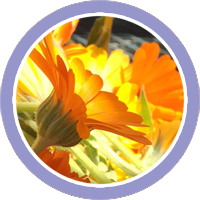 Calendula (Calendula officinalis) Called “The Calendar Herb”, because it blooms year round, and “Herb of the Sun” because it opens in the morning sun and closes when the sun sets. It’s cheerful nature and bright color can cheer us up too. Most known as a resinous herb for healing the skin topically in oils and salves. It is also a helpful astringent, antiseptic, antifungal and antibacterial plant which makes it a great topical wound-healing treatment. The tincture can be taken internally to stimulate the flow of bile, ease digestion, and as a liver tonic.
Calendula (Calendula officinalis) Called “The Calendar Herb”, because it blooms year round, and “Herb of the Sun” because it opens in the morning sun and closes when the sun sets. It’s cheerful nature and bright color can cheer us up too. Most known as a resinous herb for healing the skin topically in oils and salves. It is also a helpful astringent, antiseptic, antifungal and antibacterial plant which makes it a great topical wound-healing treatment. The tincture can be taken internally to stimulate the flow of bile, ease digestion, and as a liver tonic.
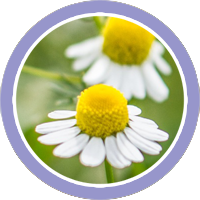 Chamomile (Matricaria chamomilla) This tonic herb has a broad spectrum of uses from cold prevention to digestive aid, to healing skin, to soothing the nervous system. We take it in our family for all of the above. It’s also a great children’s herb. I massage chamomile oil on the bottoms of my daughter’s feet each night before bed. She absolutely loves it, requests it, and it It smells soooo good!
Chamomile (Matricaria chamomilla) This tonic herb has a broad spectrum of uses from cold prevention to digestive aid, to healing skin, to soothing the nervous system. We take it in our family for all of the above. It’s also a great children’s herb. I massage chamomile oil on the bottoms of my daughter’s feet each night before bed. She absolutely loves it, requests it, and it It smells soooo good!
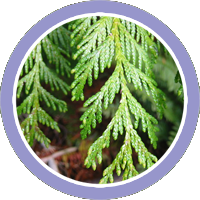 Cedar (Thuja plicata) Western Red Cedar is an antifungal herb of the most powerful kind. I use it topically in salve and oil to treat dandruff, warts, toenail fungus, wedding band or ring fungus, and ringworm. It works fast! Also an effective insect repellant, and it’s antibacterial quality makes it good for treating urinary tract infections.
Cedar (Thuja plicata) Western Red Cedar is an antifungal herb of the most powerful kind. I use it topically in salve and oil to treat dandruff, warts, toenail fungus, wedding band or ring fungus, and ringworm. It works fast! Also an effective insect repellant, and it’s antibacterial quality makes it good for treating urinary tract infections.
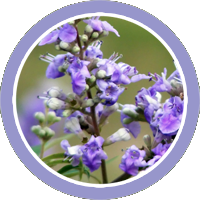 Chaste Tree (Vitex agnus-castus) A female tonic nourishing to the pituitary gland, well-known to regulate menstruation, restore hormonal balance, relieve PMS, and menopausal symptoms. Take this tincture twice a day, every day for at least 6 weeks before expecting to see any change, then it begins to work! Moon cycle stabilized.
Chaste Tree (Vitex agnus-castus) A female tonic nourishing to the pituitary gland, well-known to regulate menstruation, restore hormonal balance, relieve PMS, and menopausal symptoms. Take this tincture twice a day, every day for at least 6 weeks before expecting to see any change, then it begins to work! Moon cycle stabilized.
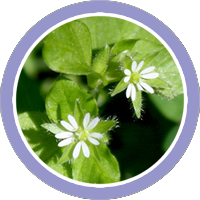 Chickweed (Stellaria media) This wild herb, eaten mostly as a highly nutritious green in early spring is soothing and healing to the skin as well. Used to treat eczema, psoriasis, dry irritated skin and bug bites. In her herb book, Gail Faith Edwards says chickweed has great “healing, cooling, drawing, and dissolving abilities”. The tincture (25-40 drops, 4 times/day) can dissolve ovarian cysts, and reduce swollen glands. Many Native American tribes use it to prevent cancer. Chickweed weakens bacteria and has the actions of cooling and expectorant which makes it great for dealing with bronchial problems, chest colds, pneumonia, and asthma (20-40 drops of tincture at least 2x/day) The tincture also helps reduce pain and swelling in the joints (20-30 drops 3x/day).
Chickweed (Stellaria media) This wild herb, eaten mostly as a highly nutritious green in early spring is soothing and healing to the skin as well. Used to treat eczema, psoriasis, dry irritated skin and bug bites. In her herb book, Gail Faith Edwards says chickweed has great “healing, cooling, drawing, and dissolving abilities”. The tincture (25-40 drops, 4 times/day) can dissolve ovarian cysts, and reduce swollen glands. Many Native American tribes use it to prevent cancer. Chickweed weakens bacteria and has the actions of cooling and expectorant which makes it great for dealing with bronchial problems, chest colds, pneumonia, and asthma (20-40 drops of tincture at least 2x/day) The tincture also helps reduce pain and swelling in the joints (20-30 drops 3x/day).
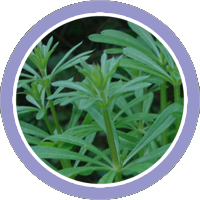 Cleavers (Galium aparine) This herb is a gift to the lymphatic system, getting it moving along and cleaned out. If lymph is the garbage system of our body, then cleavers gets it moving and cleans it up. The fresh tincture used internally and the massage oil worked directly on to the lymph node areas can clear things right up.
Cleavers (Galium aparine) This herb is a gift to the lymphatic system, getting it moving along and cleaned out. If lymph is the garbage system of our body, then cleavers gets it moving and cleans it up. The fresh tincture used internally and the massage oil worked directly on to the lymph node areas can clear things right up.
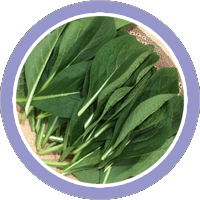 Comfrey (Symphytum officinale) Also known as “knitbone”, this herb is a very powerful healer to the bones and connective tissue in our bodies. I have witnessed many miraculous transformations, people moving very quickly from injured and debilitated to mobile once again, with the use of this oil or salve. Makes an incredible skin moisturizer too. A great one to have on hand, at the ready.
Comfrey (Symphytum officinale) Also known as “knitbone”, this herb is a very powerful healer to the bones and connective tissue in our bodies. I have witnessed many miraculous transformations, people moving very quickly from injured and debilitated to mobile once again, with the use of this oil or salve. Makes an incredible skin moisturizer too. A great one to have on hand, at the ready.
 Echinacea (Echinacea angustifolia) The most well known of the immune support herbs. It is slightly cooling and goes well with a warming herb like elderberry. Not for long term use, best taken for a period of time up to 5 weeks, and at the onset of a cold, not before. This fresh root tincture is good and tingly on the tongue, a great sign of potency.
Echinacea (Echinacea angustifolia) The most well known of the immune support herbs. It is slightly cooling and goes well with a warming herb like elderberry. Not for long term use, best taken for a period of time up to 5 weeks, and at the onset of a cold, not before. This fresh root tincture is good and tingly on the tongue, a great sign of potency.
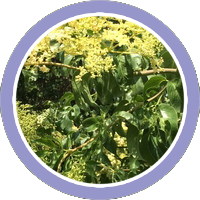 Elder (Sambucus mexicana) I use the flowers and berries of this locally abundant plant. The flowers are an upper respiratory herb, great for treating hay fever symptoms, or upper respiratory congestion. It conveniently flowers in the spring right when we need it. The flowers are also soothing and rejuvenating to the skin in an oil or lotion. The compress is very healing to the eyes. Herbalist Juliette de Bairacli Levy healed the soldiers in WWII whose eyes were burned by watching bombs explode. The syrup mixed with mineral water or water kefir makes a delightful and refreshing summer drink. The berries, ripe in the heat of summer, I use during fall and winter for making immune-strengthening syrup. It is the product I sell most, people come back for it over and over. It is antiviral, highly anti-bacterial, a great flu herb, high in iron and vitamin C, builds the blood, effective in treating anemia, and a gentle laxative. Levy calls it “The People’s Medicine Chest”. This Elder, or Grandmother of the Garden, is also a protected plant in California, like the Oaks, illegal to cut down.
Elder (Sambucus mexicana) I use the flowers and berries of this locally abundant plant. The flowers are an upper respiratory herb, great for treating hay fever symptoms, or upper respiratory congestion. It conveniently flowers in the spring right when we need it. The flowers are also soothing and rejuvenating to the skin in an oil or lotion. The compress is very healing to the eyes. Herbalist Juliette de Bairacli Levy healed the soldiers in WWII whose eyes were burned by watching bombs explode. The syrup mixed with mineral water or water kefir makes a delightful and refreshing summer drink. The berries, ripe in the heat of summer, I use during fall and winter for making immune-strengthening syrup. It is the product I sell most, people come back for it over and over. It is antiviral, highly anti-bacterial, a great flu herb, high in iron and vitamin C, builds the blood, effective in treating anemia, and a gentle laxative. Levy calls it “The People’s Medicine Chest”. This Elder, or Grandmother of the Garden, is also a protected plant in California, like the Oaks, illegal to cut down.
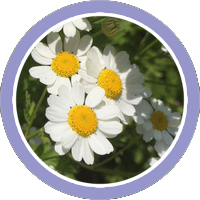 Feverfew (Tanacetum parthenium) Traditionally used as a women’s general health tonic for prevention of miscarriage, help in difficult labor, retention of afterbirth, and female infertility. Now it is becoming known as a natural treatment of migrain headaches. It can turn one around if treated early enough. At the first sign, take this herb every 10 minutes while resting. It works!
Feverfew (Tanacetum parthenium) Traditionally used as a women’s general health tonic for prevention of miscarriage, help in difficult labor, retention of afterbirth, and female infertility. Now it is becoming known as a natural treatment of migrain headaches. It can turn one around if treated early enough. At the first sign, take this herb every 10 minutes while resting. It works!
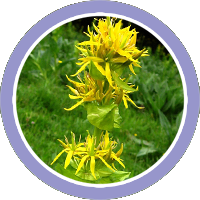 Gentian (Gentiana lutea) Strong, bitter, liver tonic herb, familiar to Alpine areas. This is the plant used most commonly in “bitters” drinks. I use the root in mine too. A fantastic digestive aid to rely on. A general health tonic herb. If you can’t stand bitters, you probably need them. My Bitters Digestive Cordial is a great way to ease into trying them as it has delicious carminative spices and raw honey to go with the bitter. Can be taken before, during, after a meal, or even in-between. Bitters will effectively calm down the digestive tract and get things moving in your system.
Gentian (Gentiana lutea) Strong, bitter, liver tonic herb, familiar to Alpine areas. This is the plant used most commonly in “bitters” drinks. I use the root in mine too. A fantastic digestive aid to rely on. A general health tonic herb. If you can’t stand bitters, you probably need them. My Bitters Digestive Cordial is a great way to ease into trying them as it has delicious carminative spices and raw honey to go with the bitter. Can be taken before, during, after a meal, or even in-between. Bitters will effectively calm down the digestive tract and get things moving in your system.
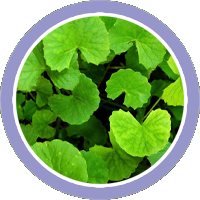 Gotu Kola (Centella asiática) This low- growing creeping perennial herb is native to, and grows all over, Asia in swampy, warm, moist climates. It smells faintly of parsley and is in the same family of plants. It is a rejuvenative nervine, indicated for the brain, focus, and clarity. It is specifically indicated for healing concussions, premature aging, and senility. A longevity herb, and a tasty food herb, it is highly regarded in Chinese medicine and Ayurveda. it is also indicated to improve hair loss and in obstinate skin conditions, such as, eczema and psoriasis.
Gotu Kola (Centella asiática) This low- growing creeping perennial herb is native to, and grows all over, Asia in swampy, warm, moist climates. It smells faintly of parsley and is in the same family of plants. It is a rejuvenative nervine, indicated for the brain, focus, and clarity. It is specifically indicated for healing concussions, premature aging, and senility. A longevity herb, and a tasty food herb, it is highly regarded in Chinese medicine and Ayurveda. it is also indicated to improve hair loss and in obstinate skin conditions, such as, eczema and psoriasis.
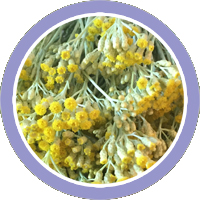 Helichrysum (Helichrysum italicum) Also known as Immortelle, Everlasting, or Curry Plant, this flowering plant, native to the dry, rocky areas of the Mediterranean, is a tissue healer in regenerative skincare. Today it is primarily distilled and used in aromatherapy practices as an essential oil. Aromatherapist Kurt Schnaubelt says, it “soothes the soul’s bruises and helps with emotional shocks.” Apparently, paleoethnobotanists have discovered its prehistoric use in the Mediterranean area for over 5000 years. (I’d like to know more about that!) I have fallen in love with this plant and I grow it in my herb garden at Botanica to make fresh infused herbal oil to be used topically. It has a very broad list of healing properties, one of those plants you can use for just about everything. I tend to go to it as a topical nervine, tissue healer, antispasmodic, analgesic, and anti-inflammatory. It also can be used as an antimicrobial, antioxidant, antiseptic, antitussive, antiviral, emollient, diuretic, antibacterial, anti fungal, astringent, febrifuge, antiallergenic, and mental stimulant. I put the essential oil in Beautiful Face Oil to enhance youthful skin, and in Flow Salve to get prana (life force) flowing again to relieve sore muscles, muscle spasms, pain and inflammation. The names Immortelle, and Everlasting come from the ability of the plant to retain the color and intense fragrance of the flowers for a very long time. The pungent, heavenly blooms are also associated with everlasting love. “That is the only purpose grand enough for a human life. Not just to love but to persist in love.” (Sue Monk Kidd, The Secret Life of Bees).
Helichrysum (Helichrysum italicum) Also known as Immortelle, Everlasting, or Curry Plant, this flowering plant, native to the dry, rocky areas of the Mediterranean, is a tissue healer in regenerative skincare. Today it is primarily distilled and used in aromatherapy practices as an essential oil. Aromatherapist Kurt Schnaubelt says, it “soothes the soul’s bruises and helps with emotional shocks.” Apparently, paleoethnobotanists have discovered its prehistoric use in the Mediterranean area for over 5000 years. (I’d like to know more about that!) I have fallen in love with this plant and I grow it in my herb garden at Botanica to make fresh infused herbal oil to be used topically. It has a very broad list of healing properties, one of those plants you can use for just about everything. I tend to go to it as a topical nervine, tissue healer, antispasmodic, analgesic, and anti-inflammatory. It also can be used as an antimicrobial, antioxidant, antiseptic, antitussive, antiviral, emollient, diuretic, antibacterial, anti fungal, astringent, febrifuge, antiallergenic, and mental stimulant. I put the essential oil in Beautiful Face Oil to enhance youthful skin, and in Flow Salve to get prana (life force) flowing again to relieve sore muscles, muscle spasms, pain and inflammation. The names Immortelle, and Everlasting come from the ability of the plant to retain the color and intense fragrance of the flowers for a very long time. The pungent, heavenly blooms are also associated with everlasting love. “That is the only purpose grand enough for a human life. Not just to love but to persist in love.” (Sue Monk Kidd, The Secret Life of Bees).
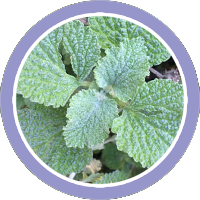 Horehound (Marrubium vulgare) Peaking in January and February here, this plant comes to us right when we need it most. It treats a cough beautifully with its expectorant, decongestant, and antibacterial actions. This tincture is strong and effective, and I’m happy to make a fresh syrup for you from this herb when it’s fresh, sweetening with raw honey.
Horehound (Marrubium vulgare) Peaking in January and February here, this plant comes to us right when we need it most. It treats a cough beautifully with its expectorant, decongestant, and antibacterial actions. This tincture is strong and effective, and I’m happy to make a fresh syrup for you from this herb when it’s fresh, sweetening with raw honey.
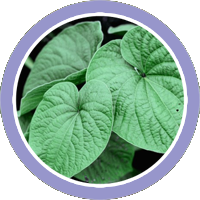 Kava Kava Root (Piper methysticum) A tropical plant native to Polynesia, Melanesia, and Micronesia, said to be in use for 3000 years. Rosemary Gladstar says kava has the unique ability to relax the body while awakening the mind. It makes you feel brighter and helps put the world in perspective. It also reduces stress and anxiety, and is pain-receiving, or analgesic. The traditional saying is, "There can be no hate in the heart when one has kava."
Kava Kava Root (Piper methysticum) A tropical plant native to Polynesia, Melanesia, and Micronesia, said to be in use for 3000 years. Rosemary Gladstar says kava has the unique ability to relax the body while awakening the mind. It makes you feel brighter and helps put the world in perspective. It also reduces stress and anxiety, and is pain-receiving, or analgesic. The traditional saying is, "There can be no hate in the heart when one has kava."
 Lady's Mantle (Alchemilla vulgaris) This rose family plant, originally from the British Isles, is an absolute wonder in its daily rhythm of dew on the leaves. It secretes the "dew" in the early morning like a shiny sparkle at the scalloped tips of the leaves, then rolls to the dipped center of the leaf by mid morning, and is re-absorbed by the plant by late morning. Absolutely amazing! In folklore, the dewdrops were thought to light the way to the Philosopher's Stone, the ability of an alchemist to turn lead into gold (hence the Latin name, Alchemilla). The dew is said to be a key ingredient in many alchemical formulas. It was also collected as a beauty lotion. As its Latin name suggests, this herb is aligned with women's health, Mother Earth, and Mother Mary. It is associated with gentleness, elegance, grace, and powerful authority. Women can do "laying on of leaves" and simply lay the fresh-picked leaves on the breasts or abdomen for treatments of various purposes. It can also be made into infusion, tincture, and oil for women's health. It is said to connect to the whole history of the matriarchy for unresolved issues with mothers and grandmothers. If this is something to work out in the family, mothers can have a toast of tea with their daughters to untie the female knots of lineage.
Lady's Mantle (Alchemilla vulgaris) This rose family plant, originally from the British Isles, is an absolute wonder in its daily rhythm of dew on the leaves. It secretes the "dew" in the early morning like a shiny sparkle at the scalloped tips of the leaves, then rolls to the dipped center of the leaf by mid morning, and is re-absorbed by the plant by late morning. Absolutely amazing! In folklore, the dewdrops were thought to light the way to the Philosopher's Stone, the ability of an alchemist to turn lead into gold (hence the Latin name, Alchemilla). The dew is said to be a key ingredient in many alchemical formulas. It was also collected as a beauty lotion. As its Latin name suggests, this herb is aligned with women's health, Mother Earth, and Mother Mary. It is associated with gentleness, elegance, grace, and powerful authority. Women can do "laying on of leaves" and simply lay the fresh-picked leaves on the breasts or abdomen for treatments of various purposes. It can also be made into infusion, tincture, and oil for women's health. It is said to connect to the whole history of the matriarchy for unresolved issues with mothers and grandmothers. If this is something to work out in the family, mothers can have a toast of tea with their daughters to untie the female knots of lineage.
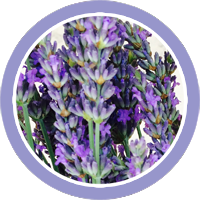 Lavender (Lavandula officinalis) Soothing lavender blossoms have been used as herbal medicine since ancient times, most known for it’s calming quality, it is also very astringent, great for treating headaches, and skin healing, especially for sores and burns. I love to put the fresh herbal oil in my salt scrubs, and salves, it smells so good and clean. Also makes a lovely massage oil. Rub this oil on your feet at night right before going to bed for a great night’s sleep.
Lavender (Lavandula officinalis) Soothing lavender blossoms have been used as herbal medicine since ancient times, most known for it’s calming quality, it is also very astringent, great for treating headaches, and skin healing, especially for sores and burns. I love to put the fresh herbal oil in my salt scrubs, and salves, it smells so good and clean. Also makes a lovely massage oil. Rub this oil on your feet at night right before going to bed for a great night’s sleep.
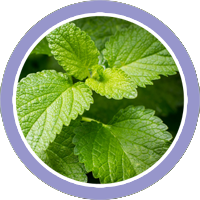 Lemon Balm (Melissa officinalis) Traditionally known as an herb for longevity, lemon balm is a very broad spectrum, multi-use, gentle herb. It’s uplifting, pain-relieving, antibacterial, skin-healing, and offers soothing and relaxing support to the general nervous system. It has a dual action of stimulating while also calming, amazing! Just right.
Lemon Balm (Melissa officinalis) Traditionally known as an herb for longevity, lemon balm is a very broad spectrum, multi-use, gentle herb. It’s uplifting, pain-relieving, antibacterial, skin-healing, and offers soothing and relaxing support to the general nervous system. It has a dual action of stimulating while also calming, amazing! Just right.
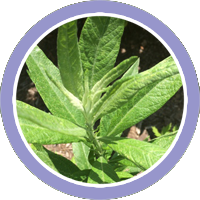 Mugwort (Artemisia douglasiana) A favorite herb growing in abundance here, this is one of our most powerful local medicines. It is a traditional sacred and protective herb with very special healing qualities. Mugwort is intensely cleansing, clearing, antispasmotic, bitter and antiparasitic. I use it for many things. It’s great to take traveling to places where it’s likely you’ll encounter parasites in the food and water. I take a dropperful each morning of the trip to keep the bugs away. It’s also a powerful dream herb to enhance lucid dreaming when taken before bed. It can calm down a muscle spasm very quickly, when used internally and externally. It is a digestive bitter as well. It can be made into a smudge stick to burn and clear the air of unwanted energy. The tincture and oil can be used in this way too, bringing things to the surface of the body to clear out.
Mugwort (Artemisia douglasiana) A favorite herb growing in abundance here, this is one of our most powerful local medicines. It is a traditional sacred and protective herb with very special healing qualities. Mugwort is intensely cleansing, clearing, antispasmotic, bitter and antiparasitic. I use it for many things. It’s great to take traveling to places where it’s likely you’ll encounter parasites in the food and water. I take a dropperful each morning of the trip to keep the bugs away. It’s also a powerful dream herb to enhance lucid dreaming when taken before bed. It can calm down a muscle spasm very quickly, when used internally and externally. It is a digestive bitter as well. It can be made into a smudge stick to burn and clear the air of unwanted energy. The tincture and oil can be used in this way too, bringing things to the surface of the body to clear out.
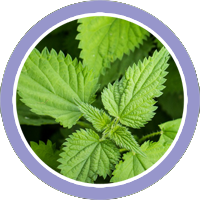 Nettle (Urtica dioica) Fresh ethically wildcrafted nettles will serve the health in so many ways. It is said that it is the most nutritious plant for us! Most notably, it is anti inflammatory. We all need that. Just watch your hay fever and arthritis start to disappear. It is also extremely rich in iron, calcium and much much more. It nourishes the adrenals, builds energy, lessens PMS symptoms, enhances breast milk production, and combats anemia and fatigue just to name a few.
Nettle (Urtica dioica) Fresh ethically wildcrafted nettles will serve the health in so many ways. It is said that it is the most nutritious plant for us! Most notably, it is anti inflammatory. We all need that. Just watch your hay fever and arthritis start to disappear. It is also extremely rich in iron, calcium and much much more. It nourishes the adrenals, builds energy, lessens PMS symptoms, enhances breast milk production, and combats anemia and fatigue just to name a few.
 Oak (Quercus agrifolia) The abundant Coast Live Oak in my area has young tender leaves in the early spring that are very waxy, bright, and full of promise. Opposite of the redwood, it grows very slowly, but still attains a very large size. King Arthur’s round table was said to have been made from a single cross section of a very large oak. The bark is traditionally used in medicine for its tonic, astringent, bitter, and antiseptic qualities. The leaves and stems can also be used. The fresh plant leaf tincture that I made can be used foremost for its astringent quality. Diluted, it is a great mouthwash for sore gums or sore throat. It is soothing to a stomach ache or ulcer pain and effective on diarrhea too.
Oak (Quercus agrifolia) The abundant Coast Live Oak in my area has young tender leaves in the early spring that are very waxy, bright, and full of promise. Opposite of the redwood, it grows very slowly, but still attains a very large size. King Arthur’s round table was said to have been made from a single cross section of a very large oak. The bark is traditionally used in medicine for its tonic, astringent, bitter, and antiseptic qualities. The leaves and stems can also be used. The fresh plant leaf tincture that I made can be used foremost for its astringent quality. Diluted, it is a great mouthwash for sore gums or sore throat. It is soothing to a stomach ache or ulcer pain and effective on diarrhea too.
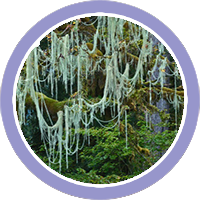 Old Man's Beard (Usnea californica) Old Man's Beard is a lichen that hangs on pines, oaks, Douglas fir, Apple trees, or other fruit trees, and is abundant around the world. Master Herbalist, Dr. Christopher Hobbs, says it has a "symbiotic relationship with the tree." He indicates it can be used as an herbal antibiotic as well as a powerful anti-fungal treatment. As an antibiotic, it is specifically indicated as a remedy for urinary tract infections and whooping cough, but can also be generally applied in the case of infection. as an anti-fungal herb it is specifically indicated for the treatment of athletes foot, but as well can be applied to other fungal issues as well on the skin and scalp. Personally I have used the tincture for a viral infection and could feel it starting to turn around 20 minutes after taking it. My energy completely shifted. The Chinese name for this greatly revered herb is "Sun-lo" as Hobbs says "it is considered to be more effective than penicillin."
Old Man's Beard (Usnea californica) Old Man's Beard is a lichen that hangs on pines, oaks, Douglas fir, Apple trees, or other fruit trees, and is abundant around the world. Master Herbalist, Dr. Christopher Hobbs, says it has a "symbiotic relationship with the tree." He indicates it can be used as an herbal antibiotic as well as a powerful anti-fungal treatment. As an antibiotic, it is specifically indicated as a remedy for urinary tract infections and whooping cough, but can also be generally applied in the case of infection. as an anti-fungal herb it is specifically indicated for the treatment of athletes foot, but as well can be applied to other fungal issues as well on the skin and scalp. Personally I have used the tincture for a viral infection and could feel it starting to turn around 20 minutes after taking it. My energy completely shifted. The Chinese name for this greatly revered herb is "Sun-lo" as Hobbs says "it is considered to be more effective than penicillin."
 Osha (Lingusticum porterii) Osha is a Native American word for Bear, hence the common name Bear Root. This is my “go to” cold and flu prevention herb. I carry it with me always. It is so very powerful. This is big medicine. When you take this herb, everyone around you knows it, can smell it’s strength. More warming than ginger, it is an amazing circulatory stimulant. It can relieve the onset of a sore throat in no time and clears mucous from the lungs, even old stubborn lung congestion. I take 15 drops of this tincture in warm water and tuck into bed as a very effective cold-chaser. Only taken for short periods of time and only in small amounts. This is not a children’s herb or pregnancy herb. Important to note is that it is also overharvested and not in cultivation. It is a wild plant of the Rocky Mountains above 7000 feet. I have found a Native American company that sustainably harvests in Taos, New Mexico that I feel good about supporting.
Osha (Lingusticum porterii) Osha is a Native American word for Bear, hence the common name Bear Root. This is my “go to” cold and flu prevention herb. I carry it with me always. It is so very powerful. This is big medicine. When you take this herb, everyone around you knows it, can smell it’s strength. More warming than ginger, it is an amazing circulatory stimulant. It can relieve the onset of a sore throat in no time and clears mucous from the lungs, even old stubborn lung congestion. I take 15 drops of this tincture in warm water and tuck into bed as a very effective cold-chaser. Only taken for short periods of time and only in small amounts. This is not a children’s herb or pregnancy herb. Important to note is that it is also overharvested and not in cultivation. It is a wild plant of the Rocky Mountains above 7000 feet. I have found a Native American company that sustainably harvests in Taos, New Mexico that I feel good about supporting.
 Redwood (Sequoia sempervirens) The largest living thing on earth, and one of the oldest too, call upon this herb for the strength to heal yourself. With bark up to two feet thick, the protective qualities of this plant are magnificent. It is associated with the planet Jupiter, the element of fire, the symbol of balance, and the Norse God Thor, spirit of thunder and lightening. It’s roots never die. If the tree is harvested, new trees grow up all around. I use the fresh spring greens to make tea, tincture, and oil. Medicinally, Michael Moore says, “The tea is an elegant tasting remedy for the recuperative stage of a lung infection.” It treats a simple chest cold, and is helpful for mild bladder infections. I just want to be near one of these giants to feel it’s power. That’s medicine!
Redwood (Sequoia sempervirens) The largest living thing on earth, and one of the oldest too, call upon this herb for the strength to heal yourself. With bark up to two feet thick, the protective qualities of this plant are magnificent. It is associated with the planet Jupiter, the element of fire, the symbol of balance, and the Norse God Thor, spirit of thunder and lightening. It’s roots never die. If the tree is harvested, new trees grow up all around. I use the fresh spring greens to make tea, tincture, and oil. Medicinally, Michael Moore says, “The tea is an elegant tasting remedy for the recuperative stage of a lung infection.” It treats a simple chest cold, and is helpful for mild bladder infections. I just want to be near one of these giants to feel it’s power. That’s medicine!
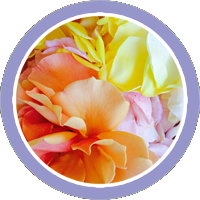 Rose (Rosa species. Rosaceae) One of the most ancient of plants, it could be said to be like a mother to the plants that came thereafter. Commonly representing the flower of love, it communicates a sensual language lovers and roses can speak. It is a flower for beauty, an aphrodesiac, and uplifting to the spirit. Rose lore says it is a goddess flower, long ago and still today laid on statues from Aphrodite to Isis and Mother Mary around the world. I absolutely love roses. They grow everywhere, wild and cultivated. Without a doubt, each time I smell a fragrant rose, I am changed, ahhhh. Juliette de Bairacli Levy says internally it is a "valuble tonic for the whole system and especially good for the heart." It is a reproductive system tonic for both men and women, gently astringent, soothing to the nerves, nourishing to the heart and circulatory system, and gently laxative too. The fruits, or hips have loads more vitamin C than oranges. Per 100 grams, rosehips have 2000 mg and oranges 50 mg. The hips are also cooling, and "of much benefit for cure of all female ailments." (Levy) They can be added to winter teas for cold and flu prevention. Externally, the flower petals are wonderfully moisturizing, soothing and cooling to the skin making beautiful lotions, oils, salves and toner sprays. Rosewater mixed with saline is so soothing for sore eyes. At Raphael Garden, we made a healing rose petal bag balm for our cow, Mona, who had some irritation on her teats from milking.
Rose (Rosa species. Rosaceae) One of the most ancient of plants, it could be said to be like a mother to the plants that came thereafter. Commonly representing the flower of love, it communicates a sensual language lovers and roses can speak. It is a flower for beauty, an aphrodesiac, and uplifting to the spirit. Rose lore says it is a goddess flower, long ago and still today laid on statues from Aphrodite to Isis and Mother Mary around the world. I absolutely love roses. They grow everywhere, wild and cultivated. Without a doubt, each time I smell a fragrant rose, I am changed, ahhhh. Juliette de Bairacli Levy says internally it is a "valuble tonic for the whole system and especially good for the heart." It is a reproductive system tonic for both men and women, gently astringent, soothing to the nerves, nourishing to the heart and circulatory system, and gently laxative too. The fruits, or hips have loads more vitamin C than oranges. Per 100 grams, rosehips have 2000 mg and oranges 50 mg. The hips are also cooling, and "of much benefit for cure of all female ailments." (Levy) They can be added to winter teas for cold and flu prevention. Externally, the flower petals are wonderfully moisturizing, soothing and cooling to the skin making beautiful lotions, oils, salves and toner sprays. Rosewater mixed with saline is so soothing for sore eyes. At Raphael Garden, we made a healing rose petal bag balm for our cow, Mona, who had some irritation on her teats from milking.
 Saint John’s Wort (Hypericum perforatum) Just looking at this beautiful scarlet tincture and oil can lift the spirits. Famous for it’s mild anti-depressant qualities, this “Solstice Herb”, which flowers around the summer solstice in Europe where it’s from, is also a powerful antiviral, antibacterial, antifungal, antispasmotic, nervine, and anti-inflammatory plant. In ancient times, the tincture and oil of Saint John’s Wort were carried for wound healing as well as a symbol of the red blood of Christ. This is the best burn treatment herb, it’s salve acting like a piece of ice on a new burn, which after 40 minutes of application is so healed it’s as though it never happened! I’ve experienced it myself. It’s also a great herb for soothing muscle spasms with direct application. A restorative tonic that nourishes the entire nervous system, it also is a very effective nerve treatment for accidents and surgeries.
Saint John’s Wort (Hypericum perforatum) Just looking at this beautiful scarlet tincture and oil can lift the spirits. Famous for it’s mild anti-depressant qualities, this “Solstice Herb”, which flowers around the summer solstice in Europe where it’s from, is also a powerful antiviral, antibacterial, antifungal, antispasmotic, nervine, and anti-inflammatory plant. In ancient times, the tincture and oil of Saint John’s Wort were carried for wound healing as well as a symbol of the red blood of Christ. This is the best burn treatment herb, it’s salve acting like a piece of ice on a new burn, which after 40 minutes of application is so healed it’s as though it never happened! I’ve experienced it myself. It’s also a great herb for soothing muscle spasms with direct application. A restorative tonic that nourishes the entire nervous system, it also is a very effective nerve treatment for accidents and surgeries.
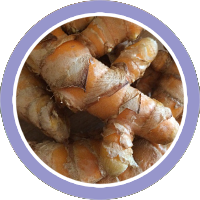 Turmeric (Curcuma longa) There’s so much buzz about this herb, it’s been called one of the “World’s Healthiest Foods”. It is a very powerful anti-inflammatory herb for a broad treatment of inflammatory conditions from digestive to menstrual, from rheumatic to cardiovascular, and produces no toxicity. It’s also known to prevent, as well as treat, cancer and Alzheimers disease. It improves liver function too. A powerful daily health tonic. I get my supreme quality dried powder from The Big Island’s, Ginger Hill Farm.
Turmeric (Curcuma longa) There’s so much buzz about this herb, it’s been called one of the “World’s Healthiest Foods”. It is a very powerful anti-inflammatory herb for a broad treatment of inflammatory conditions from digestive to menstrual, from rheumatic to cardiovascular, and produces no toxicity. It’s also known to prevent, as well as treat, cancer and Alzheimers disease. It improves liver function too. A powerful daily health tonic. I get my supreme quality dried powder from The Big Island’s, Ginger Hill Farm.
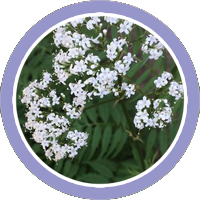 Valerian (Valeriana officinalis) Also known as “all-heal” this root medicine is a natural and effective pain reliever and sedative affecting the cerebrospinal system, an all- around supreme medicine for the nerves. It is also a mineral-rich tonic, carminative, and antispasmotic. Using this fresh root tincture will calm and sooth the nervous system for a wonderful night’s rest, or a calm day, and much more.
Valerian (Valeriana officinalis) Also known as “all-heal” this root medicine is a natural and effective pain reliever and sedative affecting the cerebrospinal system, an all- around supreme medicine for the nerves. It is also a mineral-rich tonic, carminative, and antispasmotic. Using this fresh root tincture will calm and sooth the nervous system for a wonderful night’s rest, or a calm day, and much more.
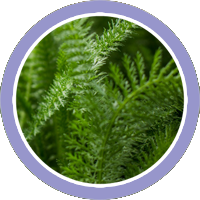 Yarrow (Achillea millefolium) Millefolium, or a thousand leaves, indicates the feathery, airy quality of the leaves. They are like a picture of our fine blood vessels or our nerves, and are considered a signiture for sensitivity. It's no wonder this plant's nickname is "nosebleed plant", and can be poulticed to stop a nose bleed or other external bleeding. The plant is named after Achilles, the Greek warrior, who first healed his own, and other's wounds with it. It also has antiinflammatory, pain releiving, and astringent qualities which help in treating a topical wound. It is notoriously diaphoretic and effective in treating fevers, stimulating circulation, and promoting perspiration. It's bitter quality points to the digestive help the plant lends. It's also ansispasmotic and can smooth out the digestive process. It is a women's herb which helps to tonify the uterus and regulate the monthly flow, especially when very heavy. It is also used to get a hesitant flow moving in women. The same plant with the opposite benefits, wow.
Yarrow (Achillea millefolium) Millefolium, or a thousand leaves, indicates the feathery, airy quality of the leaves. They are like a picture of our fine blood vessels or our nerves, and are considered a signiture for sensitivity. It's no wonder this plant's nickname is "nosebleed plant", and can be poulticed to stop a nose bleed or other external bleeding. The plant is named after Achilles, the Greek warrior, who first healed his own, and other's wounds with it. It also has antiinflammatory, pain releiving, and astringent qualities which help in treating a topical wound. It is notoriously diaphoretic and effective in treating fevers, stimulating circulation, and promoting perspiration. It's bitter quality points to the digestive help the plant lends. It's also ansispasmotic and can smooth out the digestive process. It is a women's herb which helps to tonify the uterus and regulate the monthly flow, especially when very heavy. It is also used to get a hesitant flow moving in women. The same plant with the opposite benefits, wow.
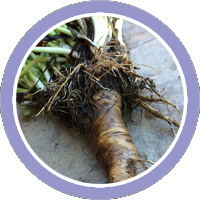 Yellow Dock (Rumex crispus) Yellow dock root is a great digestive herb, and can purge the liver, its bitterness speaks to the nourishing and strengthening quality for the liver. The roots also contain concentrated iron and is a blood enriching tonic. It is a gentle and effective laxative. Known to relieve arthritis and inflammatory conditions as well as eczema and psoriasis. It is noted as a Native American cure for cancer too.
Yellow Dock (Rumex crispus) Yellow dock root is a great digestive herb, and can purge the liver, its bitterness speaks to the nourishing and strengthening quality for the liver. The roots also contain concentrated iron and is a blood enriching tonic. It is a gentle and effective laxative. Known to relieve arthritis and inflammatory conditions as well as eczema and psoriasis. It is noted as a Native American cure for cancer too.
 Hawthorn Berry (Crataegus) Medicinally, this plant in the rose family is cardiotonic, helpful for all kinds of heart concerns. Its antioxidant flavonoids and high poly phenol improve blood flow and help dilate blood vessels. Personally, I find it essential during acclimation to high altitude. The decrease in air oxygen levels cause dehydration and thickens the blood, causing the issues... fatigue, edema, nausea, headache, breathlessness... Adaptogenic ashwaganda and good ol' vitamin C, also help.
Hawthorn Berry (Crataegus) Medicinally, this plant in the rose family is cardiotonic, helpful for all kinds of heart concerns. Its antioxidant flavonoids and high poly phenol improve blood flow and help dilate blood vessels. Personally, I find it essential during acclimation to high altitude. The decrease in air oxygen levels cause dehydration and thickens the blood, causing the issues... fatigue, edema, nausea, headache, breathlessness... Adaptogenic ashwaganda and good ol' vitamin C, also help.
Additionally, Hawthorn Berry Tincture is antioxidant, digestive, anti inflammatory, nervine, boosts immune function, and is even said to prevent hair loss.
A Word to the Wise
I encourage all of my clients to do research on their herbal products, know their self care intimately and take a role in their preventive health care. If you are taking prescription medications herbal products can interfere with their effectiveness, so please be cautious.
